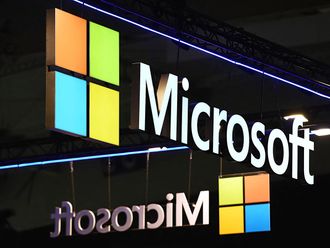
The digital signage market was estimated to be worth nearly $14 billion (Dh51.4 billion) in 2013 with data-centric information and analytics driving up revenue, according to new research.
Worldwide revenue for digital signage equipment, software, services and media reportedly reached $13.9 billion at the close of the year, a rise of 5.6 per cent from $13.2 billion in 2012, according to research firm IHS.
Last year’s growth improves upon the 3.9 per cent expansion seen in 2012, and the next few years will see a continued steady increase in revenue, ranging from 4.7-5.6 per cent. By 2017, total digital signage takings will amount to more than $17 billion.
Doing digital
Kate Spade, adidas and Harvey Nichols are just a few of the international retailers making use of the technology. Many fast-food restaurants are also employing digital signage to replace static signs with digital menu boards.
“Improvements in technological offerings, data management and infrastructure expansion will help the digital signage industry continue the positive momentum it has already generated,” Sanju Khatri, Director for signage and public information displays at IHS, said in a media statement in October. “And as digital signage becomes increasingly intelligent with smart content and dynamic interfaces, the integration of real-time data management into real-world applications will further stimulate revenue growth.”
The integration of real-time data and predictive analytics into digital signage is making a big splash among retailers, which are using digital signage solutions to target customers more efficiently, leading to increased dwell time, improved shopping experiences and a rise in sales.
Overall, the retail market continues to be the strongest source of revenue for the digital signage industry, with plenty of stores using these systems to promote brands or merchandise, while also being able to simultaneously entertain or educate customers. The retail sector will make up approximately 42 per cent of total digital signage display revenue from 2013 to 2017, IHS predicts, with North America and Western Europe as the leading retail markets.
Hybrid shopping
Earlier this year, CNN reported on the rise of digital storefronts, a new hybrid shopping concept. These are giant touchscreen store windows where customers can browse through a retailer’s items with a few swipes. Once they find something, they can hit the order button and a link will be sent to their mobile phone, allowing them to pay via PayPal or credit/debit card. The concept has been rolled out at Westfield San Francisco Center to bring the best of online and new technologies to the physical world. Retailers Sony, TOMS and Rebecca Minkoff have all set up Connected Glass points in the mall. Of the three, only Sony has a physical outlet there.
Other applications employing live data feeds include corporations using digital signage networks to improve efficiency in the workplace and allow for easier connectivity across large businesses.
Digital signage has likewise become increasingly prevalent throughout many universities to show upcoming event details, as well as display building directories, maps and emergency messages to increase student and faculty safety. Other examples of live data feeds for digital signage include news updates, weather, traffic highlights, stock quotes or local event material. Similarly, live data feeds can be useful in programming networked content management software to provide real-time information on a broad range of material, including sales data, emergency notifications, public transit schedules and service warnings.












